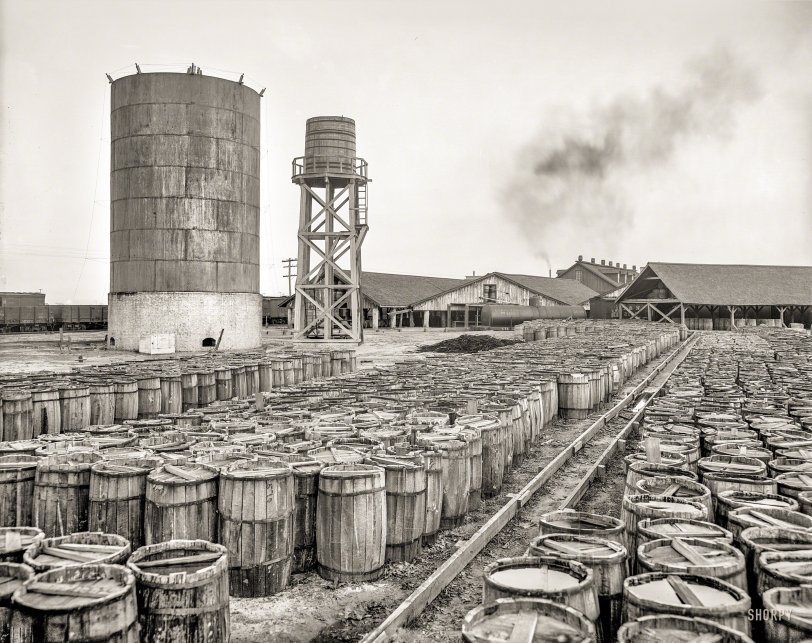


Framed or unframed, desk size to sofa size, printed by us in Arizona and Alabama since 2007. Explore now.
Shorpy is funded by you. Patreon contributors get an ad-free experience.
Learn more.

- Air Quality?
- Sojourner Truth riot
- None were so blind(ed)
- The less famous sister
- Good ol' days?
- Rise and Fall
- Goo Goo Ga Joob
- Ticket Retention
- Not the only one
- Vagaries of War
- Killed by Amtrak
- Back to the Future
- Wanted --
- If you can't stand the light
- Centralized Traffic Control, I believe
- What's really happening
- Heckuva remote control!
- Sometimes — Things Go Bump!
- I SEE THE LIGHT
- Union Switch and Signal Company
- Get That Light Out Of My Eyes
- Eggs. Eggs. Eggs. The Egg Man is Here!
- Foreboding caption
- Famous Hollywood faces
- Not just S&P
- re: Those things in the jar
- Up In Smoke
- Medical Smoking
- Quick fix
- A Quink Comment
Print Emporium
Tank & Barrel: 1903

1903. "Plant of the Consolidated Naval Stores Company, Pensacola, Florida. Resin and turpentine." 8x10 inch dry plate glass negative. View full size.
The barrel shape
with a 'belly' also made them much easier to turn when on their sides because of the narrow contact patch one person could easily roll them around.
Newer steel and plastic drums are primarily designed for handling with carts or lifts and depending on weight can take a couple people to get them to turn when rolling.
Barrel track
The barrels, owing to their shape, will self-center and roll the length of the 'track'. Thus no cart is necessary. So 'roll out the barrel, we'll have a barrel of fun' (as the song says).
Cheap railroad?
Can anyone address the two parallel lines of wooden boards down the middle of the barrel storage area? An inexpensive "railroad" for carts carrying barrels, perhaps?
Where there's pine, there's turpentine
The pine forests of the southern US were the main source for turpentine and "naval stores" during the late 19th and early 20th century. Southeast Texas provided its share of pine trees to the naval stores market, to the point that a town in Jasper County was named Wenasco [trade name for the Western Naval Stores Company].
Roof Barrels
Those barrels on the ridge of the roof are water-filled, and very effective, immediate fire extinguishers. We saw these mounted on sawmills here until the 1960s. In the era of self-sufficiency, these were about state of the art.
I think your sacrificial trailer parks are probably just a placebo for your community, but these barrels were very much on the front line of fire protection.
[A lot of these rooftop barrels and pails were filled not with water but sand. - Dave]
I suppose sand would be a better choice in some instances. But, I'd rather pump up water than lug up sand!
Sacrificial barrels on storage barn
It appears the half-dozen or so barrels on the peak of the roof of the building in the background are decoys for lightning. Here in GA, we have decoy trailer parks for tornadoes to scatter, leaving the real ones untouched. I suspect both work just as well at their task.
Where are the signs?
There should be about 100 "No Smoking" signs plastered all over the site.
Wooden barrels (dry and aged, from appearance) filled with turpentine, or pitch, and heated in the sun and exuding all sorts of aromatics, the site is a fire hazard awaiting the match.
Given that Florida is the "Lightning Capital of the World", I would suspect the conductors are for lightning dissipation. If the array had been a bit closer, I would have thought it might make a Farady Cage, which would be an excellent lightning protector. As it is, circling the top, and repeating the circle down the side of the tank multiple times, there is a conductor to ground close at hand for lightning to connect with surrounding the tank. Only question I have is that the diameter of the wire is so small, and would likely vaporize if it had to pass common lightning amperage.
The lightning protection wires on a 100-year newer building(well, 90)in Atlanta at the 20th+ floor were almost the diameter of a large "Magic Marker" tube, a common office item for comparison. That shown appears to be common barbed wire, not the 'thumb size' of modern conductors.
























On Shorpy:
Today’s Top 5